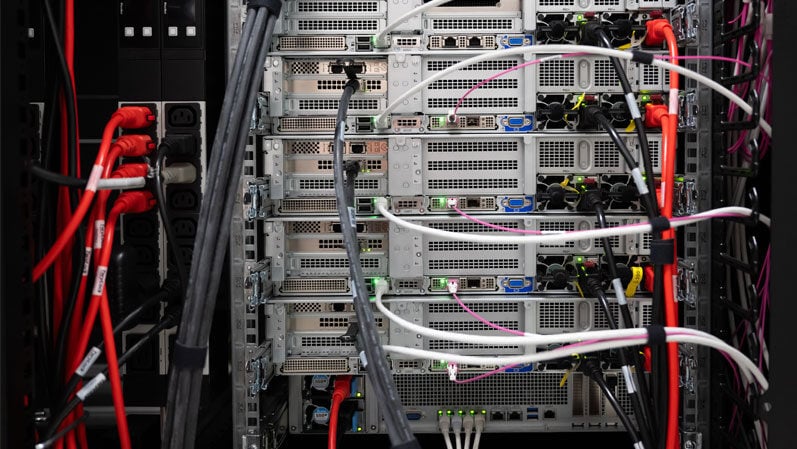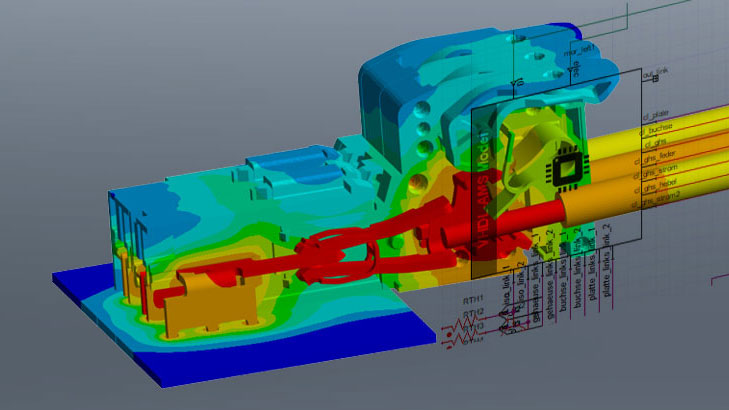Simulation and Cloud Technology: Benefits and Performance
Dr.-Ing. Jürgen Vogt
16.07.2024
Interview with Dr. Sandeep Sovani, Global Head of GTM for Engineering Simulation on the Cloud at AWS
AWS Cloud Technology offers a broad range of benefits in terms of usage, performance, and security. In this interview, Dr. Sandeep Sovani talks about the advantages of simulation in the cloud and improvements for engineers and companies.
Dr. Sandeep Sovani (AWS), Dr. Jürgen Vogt (CADFEM Germany GmbH), Derek Sweeney (CADFEM Ireland Ltd.) | © CADFEM Germany GmbH
CADFEM is completely convinced about the benefits of cloud technology for all our engineering services, including training and consulting. However, customers still hesitate to adopt cloud solutions. Why should a simulation engineer use cloud services?
If we look at where things are today, I’d say that more than 95 % of simulation is still being run outside of the cloud. However, customers are rapidly moving to the cloud for several reasons: Firstly, the cloud has enormous scale. Typically, you have a limited number of computer resources on premises. But on the cloud, you get a lot of elasticity on a pay-per-use model. Instead of having a capital expense, there could be an operational expense, and that can provide agility to a business.
Additionally, on the cloud, we are always installing the latest processors, which improve the performance of engineers' simulation jobs. There is also better disaster resilience available on the cloud. We work very closely with Ansys on benchmarking performance for various solvers, so that our customers get the best performance out of the cloud.
Performance is something every simulation engineer wants. However, a typical concern is the safety of the data. Why, especially on your cloud, are the data secure?
Security is the number one priority at AWS. We have over 300 different security-related and compliance-related services. AWS Cloud is designed in a way to maintain security standards at the highest levels for the military, global banks, and other organizations with very high data sensitivity requirements. We comply with over 140 different security standards all around the world, which gives customers confidence in the security of the cloud. We have a special pillar for security in any solution that customers build on the cloud.
Are there big technology hits that will improve things for engineering coming up?
Computation really depends on the processors. We are therefore constantly implementing the latest processors, whether they're from AMD or Intel. Additionally, Amazon creates its own processors. These Graviton processors are a unique innovation and are particularly good from a sustainability perspective because they consume about 60% less energy than traditional processors.
In terms of services, we are building tools that make it easier for customers to deploy high-performance computing workloads on AWS. We now have a new tool called “Research and Engineering Studio”, which can be used to manage a fleet of virtual desktops, allowing engineers to work from a thin client like a laptop from which they can do all pre-processing and post-processing and keep all the data in the cloud.
Of course, you are aware that Ansys Fluent runs perfectly on GPUs. However, the current shortage in availability is a big challenge. How can you help?
Oftentimes, customers would come to us to run their GPU codes because they're not able to find GPUs elsewhere. Thanks to the pay-per-use model customers come and try out the GPU solvers very easily. Users don't have to try to buy expensive GPUs.
Customers are rapidly moving to the cloud for several reasons.
So, you're investing a lot to make technology available. What impact do you think that has on the product development process on the larger scale for the company and on a more personal scale for the simulation engineer?
For a large company, what the cloud provides is business agility. When a new product has to be launched, there is a tight timeline, and you need simulation. You can do that easily on the cloud. You can build up resources pretty quickly and dismantle them later on once that need has passed. And you're not paying for them anymore. Always staying with the latest technology also makes sure for the company that they are getting the most utilization out of their software licenses.
On a personal level, engineers will have much better turnaround time and access. The turnaround time will be much faster. They can run more simulations, they can run more complex models, and get more detailed results out of their simulations. Also, they get exposure to the cloud. There is so much happening these days and it's really good on an individual level to have some skills related to the cloud. That's a unique opportunity for simulation engineers.
Let’s step back from the technology for a moment and talk about partnerships. How crucial are local partnerships to you?
At AWS, we often say that we're customer-obsessed – but we're also partner-obsessed. We rely heavily on a vast network of partners to ensure our customers receive the best possible support. We have over 90,000 partners, we fully embrace collaboration and work closely with our partners to deliver exceptional service. We are particularly excited about our collaboration with CADFEM.
This partnership represents a close three-way collaboration between AWS, CADFEM, and Ansys. Having observed CADFEM for over 20 years in my previous role, I understand the extensive reach they have with customers, both in the DACH region and worldwide through their various subsidiaries. We are eager to work together to provide customers with advanced cloud technology that enhances their engineering simulation workflows.
Get the full interview with Dr. Sandeep Sovani on our YouTube channel!





